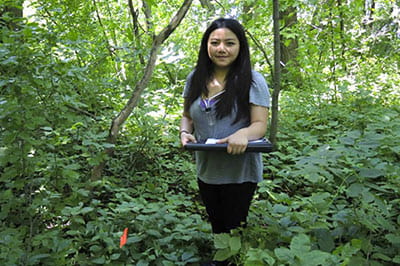 Ten University of Wisconsin-Green Bay students will report on research conducted in UW-Green Bay natural areas at the 25th annual Cofrin Student Symposium, scheduled from 1-5 p.m. Tuesday, March 4 in the Christie Theatre of the University Union on campus, 2420 Nicolet Drive.
Ten University of Wisconsin-Green Bay students will report on research conducted in UW-Green Bay natural areas at the 25th annual Cofrin Student Symposium, scheduled from 1-5 p.m. Tuesday, March 4 in the Christie Theatre of the University Union on campus, 2420 Nicolet Drive.
The symposium marks a quarter-century of student research and more 140 students whose research has been funded by an endowment established by the Cofrin family. The program also will include recognition of the recipient of the Paul and Thea Sager Scholarship for excellence in scientific writing, presented to Holly Plamann, for her paper entitled “Can Added Sugar Intake Increase the Risk of Developing Pancreatic Cancer?” The event is free and open to the public.
Six undergraduate and four graduate students will present their results. Two graduate students will present on their thesis research associated in part with the Cat Island Chain restoration in the bay of Green Bay. Tim Flood is working to restore native aquatic vegetation and improve habitat for fish and waterfowl in the Cat Island restoration area, while Tom Prestby is identifying and mapping shorebird habitat along the lower Green Bay coastal zone, including UW-Green Bay natural areas and Cat Island.
Two student projects were focused on the identification of bat assemblages in northeastern Wisconsin. Graduate student Jessica Kempke will discuss her research to identify bat migration patterns along the Lake Michigan coast. In a continuation of research started in 2012, Brianna Kupsky will report on bat species living in UW-Green Bay natural areas.
Several studies by UW-Green Bay undergraduates focused on understanding the ecology of the Cofrin Memorial Arboretum or nearby Point au Sable Nature Preserve. Two students used a combination of observation and cameras to learn about the behavior of mammals and the use of burrows on the Cofrin Arboretum. Christa Meyer will report on the behavior of breeding red foxes and Amanda Johnson will discuss the ecological importance of woodchuck burrows on campus. Education major Amanda Nothem developed a curriculum that will allow K-12 educators to bring groups of students to the Cofrin Arboretum to study water and atmospheric science. After the symposium the equipment and curriculum will be available for checkout through the Education department.
During the symposium, student Linda Vang will report on the dispersal of wildflower seeds by ants in Mahon Woods. Sravani Karnam will describe a mathematical model she designed, based on water chemistry and zooplankton data that will predict trophic level changes in the Arboretum ponds. Haley Sharpe will report on her study of the types of fungi that are collected by woodpeckers as they forage for insect larvae in the Point au Sable forest.
Prof. Robert Howe, director of the Cofrin Center for Biodiversity at UW-Green Bay, will introduce and moderate the session.
Click thumbnails to enter slideshow view.








